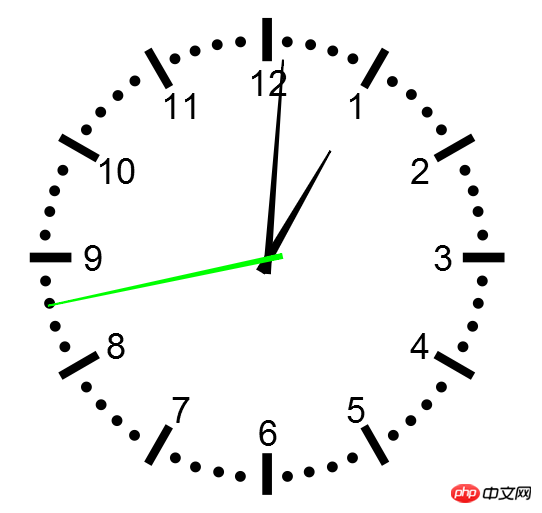
The clock made with HTML5 Canvas looks quite simple, but there are still many small problems in writing it. , interested friends can refer to

<!DOCTYPE html>
<html lang="en" >
<head>
<meta charset="utf-8" />
<title>HTML5 时钟</title>
<link href="css/main.css" rel="stylesheet" type="text/css" />
<script src="http://code.jquery.com/jquery-latest.min.js"></script>
<style>
.clocks {
height: 500px;
margin: 25px auto;
position: relative;
width: 500px;
}
</style>
</head>
<body>
<header>
<h2>HTML5 时钟</h2>
</header>
<p class="clocks">
<canvas id="canvas" width="500" height="500"></canvas>
</p>
</body>
</html>// inner variables
var canvas, ctx;
var clockRadius = 250;
var clockImage;
// draw functions :
function clear() { // clear canvas function
ctx.clearRect(0, 0, ctx.canvas.width, ctx.canvas.height);
}
function drawScene() { // main drawScene function
clear(); // clear canvas
// get current time
var date = new Date();
var hours = date.getHours();
var minutes = date.getMinutes();
var seconds = date.getSeconds();
hours = hours > 12 ? hours - 12 : hours;
var hour = hours + minutes / 60;
var minute = minutes + seconds / 60;
// save current context
ctx.save();
// draw clock image (as background)
ctx.drawImage(clockImage, 0, 0, 500, 500);
ctx.translate(canvas.width / 2, canvas.height / 2);
ctx.beginPath();
// draw numbers
ctx.font = '36px Arial';
ctx.fillStyle = '#000';
ctx.textAlign = 'center';
ctx.textBaseline = 'middle';
for (var n = 1; n <= 12; n++) {
var theta = (n - 3) * (Math.PI * 2) / 12;
var x = clockRadius * 0.7 * Math.cos(theta);
var y = clockRadius * 0.7 * Math.sin(theta);
ctx.fillText(n, x, y);
}
// draw hour
ctx.save();
var theta = (hour - 3) * 2 * Math.PI / 12;
ctx.rotate(theta);
ctx.beginPath();
ctx.moveTo(-15, -5);
ctx.lineTo(-15, 5);
ctx.lineTo(clockRadius * 0.5, 1);
ctx.lineTo(clockRadius * 0.5, -1);
ctx.fill();
ctx.restore();
// draw minute
ctx.save();
var theta = (minute - 15) * 2 * Math.PI / 60;
ctx.rotate(theta);
ctx.beginPath();
ctx.moveTo(-15, -4);
ctx.lineTo(-15, 4);
ctx.lineTo(clockRadius * 0.8, 1);
ctx.lineTo(clockRadius * 0.8, -1);
ctx.fill();
ctx.restore();
// draw second
ctx.save();
var theta = (seconds - 15) * 2 * Math.PI / 60;
ctx.rotate(theta);
ctx.beginPath();
ctx.moveTo(-15, -3);
ctx.lineTo(-15, 3);
ctx.lineTo(clockRadius * 0.9, 1);
ctx.lineTo(clockRadius * 0.9, -1);
ctx.fillStyle = '#0f0';
ctx.fill();
ctx.restore();
ctx.restore();
}
// initialization
$(function(){
canvas = document.getElementById('canvas');
ctx = canvas.getContext('2d');
// var width = canvas.width;
// var height = canvas.height;
clockImage = new Image();
clockImage.src = 'http://static.oschina.net/uploads/space/2012/0712/125855_nnla_89964.png';
setInterval(drawScene, 1000); // loop drawScene
});The above is the detailed content of Introducing a clock made with HTML5 Canvas. For more information, please follow other related articles on the PHP Chinese website!




